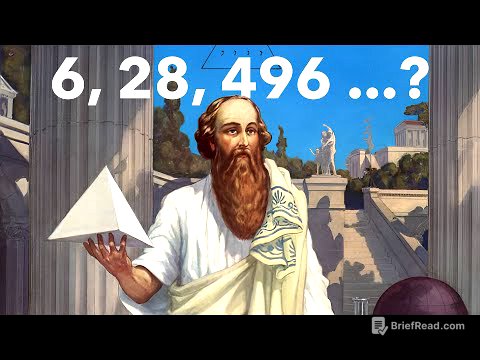TLDR;
This video explores the historical associations between Saturn and the Jews, particularly how these connections were shaped by astrological and religious ideas from antiquity through the Renaissance. It examines how Saturn, initially linked to Judaism due to its association with the Sabbath, became increasingly intertwined with negative perceptions of Jews in the European imagination, especially around the 15th century. The discussion covers the evolution of Saturn's image from a polytheistic deity to a malefic force and its subsequent restoration to ambivalence through Neoplatonic writings.
- Explores the historical associations between Saturn and the Jews.
- Examines the evolution of Saturn's image and its connection to negative perceptions of Jews.
- Discusses the role of astrological and religious ideas in shaping these associations.
Introduction: Saturn and the Jews [0:01]
The video introduces the significant and mutually influential association between Saturn and the Jews, a connection explored in detail by Eric Zephran's 1979 article, "Saturn and the Jews." This association, which evolved over centuries and across various cultures, became heavily laden with anti-Semitic sentiments in Western Europe, particularly around the 15th century. During this period, negative associations with Saturn became intertwined with negative perceptions of Jews, reinforcing each other, especially in art. Mosha Edell's monograph, "Saturn's Jews," further examines how misperceptions of the Jewish Sabbath led to connections between Jews and witchcraft, linking the witches' Sabbath with the Jewish holy day.
Origins of the Association [1:36]
The initial association between Saturn and the Jews dates back to Roman times, stemming from the idea that Saturn governed the day of the Jewish Sabbath. The seventh day, a day of rest celebrating God's cessation of creative power, was linked to Saturn, the seventh planet symbolizing inertia or retention. Saturn was considered the oldest planet, and Judaism the oldest religion. Just as Saturn's sphere encapsulated all other planetary spheres, Judaism was seen as the origin of all other faiths. Even St. Augustine proclaimed Saturn to be the god of the Jews. This link is evident in the works of Abu Mashar and later in the writings of the Arab astrologer Alcabesi, who attributed the "faith of Judaism" to Saturn in the 10th century.
Theories of Great Conjunctions [3:21]
Concepts connecting Saturn and the Jews were elaborated in the historical theory of great conjunctions, an idea of interest to Roger Bacon in the 13th century. Bacon, drawing from Abu Mashar, explained that philosophers associate Jupiter's conjunction with other planets to signify religions and faiths. A conjunction with Saturn signifies Judaism, the oldest religion, just as Saturn is the father of the planets. In contrast, Picatrix assigns different religions to each planet, but it also maintains the fundamental association between Saturn and Judaism.
Astrology in the Middle Ages [6:14]
During the Middle Ages, astrology was deeply intertwined with religion, politics, propaganda, medicine, science, philosophy, and history. This widespread fascination with astrology led to a build-up of diverse and contradictory astrological ideas, culminating in a crisis that preceded a paradigm shift. This occurred precisely as the studio humanitatis began remapping astral deities with imagery from the classics.
Saturnization of Judaism and Judaization of Saturn [7:36]
Mosha Edell describes a phenomenon known as the "Saturnization of Judaism" and the "Judaization of Saturn." By the late 15th and 16th centuries, even European Jewish cobbalists like Yahan Alammano connected ancient history, the land of Israel, Moses, the temple, the Torah, prophetic inspiration, the Sabbath, and esoteric knowledge with Saturn. Alammano described Saturn as a supreme and noble sphere, the planet of Moses, with the angel Michael as the ministering angel of Israel. He associated Saturn with profound thought, law, spiritual sciences, prophecy, sorcery, the Jewish people, the Hebrew language, and the temple.
The Influence of Picatrix and Popular Images [12:04]
By the 15th century, as the text "Picatrix" reemerged, numerous popular images and almanacs across Europe explicitly stated that Saturn governed the fate of the Jews. For example, an almanac printed by Johannes Utmar predicted misfortunes for Jews through the influence of Saturn, while Christians would have a fortunate year through Mercury and the sun. Eric Saffron notes that a current of thought over time relates the Jews and Saturn, primarily through ideas inherited from neoplatonic medieval texts on magic and astrology.
Saturn and Sorcery [13:32]
The association between Saturn and sorcery may be related to the perceived external action in Judaism. Outsiders viewed Jewish ritual complexities as consonant with the practical character of talismanic or ceremonial magic. Both magic and Judaism involve complicated systems of commandments, ritual purity, adherence to specific ritual times, and reliance on ancient scriptures, concepts that extend analogically into the dominion of Saturn.
Conclusion [14:40]
In conclusion, the video reviewed various associations attributed to Saturn in astrological texts from different cultures, including prayers, sacrifices, and ritual conditions for conjuring Saturn's spirits as detailed in the Pikatrix. While these associations have roots in polytheistic imagery, the concept of a planet evolved significantly during the Middle Ages. Saturn, initially a divinity, was demoted to a malefic force but later restored to ambivalence through Neoplatonic writings, with Picatrix playing a formative role. The video also highlighted how Saturnine imagery became entangled with negative perceptions of Jews in the European imagination.
![Saturn and the Jews [Renaissance Astral Magic Documentary] [Bonus Scene]](https://wm-img.halpindev.com/p-briefread_c-10_b-10/urlb/aHR0cDovL2ltZy55b3V0dWJlLmNvbS92aS9RdWxWSzNsa1ZkSS9tYXhyZXNkZWZhdWx0LmpwZw==.jpg)








